Dear Editor,
Angiolymphoid hyperplasia with eosinophilia (ALHE) is a rare, chronic, benign vascular proliferation of unknown aetiology, which typically presents as solitary or multiple pink-to-red papules or nodules on head or neck areas.1,2 It is usually asymptomatic, however, itching, bleeding and tenderness may be associated. Given the predilection for involvement of exposed sites and associated symptoms, if any, ALHE can be a distressing disorder for patients. Dermoscopy can be a useful diagnostic modality for this uncommonly encountered disorder, considering the rapid and non-invasive nature of the procedure. There is a shortage of literature on dermoscopy of ALHE in the skin of colour; findings are found to vary from those described in lighter skin phenotypes.3 In the current study, we retrospectively analysed the clinical profile of six biopsy-proven cases of ALHE with skin type IV–V and reviewed dermoscopic findings in a total of 17 lesions. Dermoscopy images were taken using DermLite™ DL4 (3Gen, San Juan Capistrano, CA, USA) at ×10 magnification. Dermoscopic findings were analysed for the presence of lines, dots, clod, structureless zone, vessels or else (according to International Dermoscopy Society criteria (IDS) for skin tumours for skin of colour).3 Presence of findings not delineated in the IDS criteria were recorded under “other relevant findings”.
All six patients were female (average age 39.1 years, range 24–50 years, Fitzpatrick’s phototype IV: 1, V: 5). Clinical history revealed eight lesions to be of recent onset (< 6 months) and nine lesions to be present ≥ 6 months (late lesions). None of the patients had any history of trauma or any other associations. Investigations of all patients, including eosinophil levels and renal function tests, were within normal limits. The most frequent findings were the presence of more than one type or polymorphic vessels (most commonly a combination of dotted, linear, and curved/serpentine), with polarisations specific white structures (white structureless areas, white lines, white dots), and clods (red-purple lacunes) [Table 1]. The other notable dermoscopic findings in the present analysis were brown structures (structureless zone, dots), pink structureless zones either focally or as a diffuse background, pigment network and erosions (seen as red-brown dots/globules). In addition, the peripheral rim of pigmentation and scales (most commonly patchy white) were seen. [Figures 1a–d and 2a–e]
Table 1: Dermoscopic findings of angiolymphoid hyperplasia with eosinophilia
S. No Dermoscopic findings Number of lesions (%, total lesions-17) 1.Vessels
Polymorphic
Dotted + Linear + curved/serpentine
Dotted + curved/serpentine
Dotted + Linear
Monomorphic
Dotted
16 (94.1%)
15
9
4
2
1
1
2.Lines
White
Brown
Pigment network
15 (88.2)
1 (5.8)
7 (41.1)
3.Dots
White
Brown
15 (88.2)
8 (47.0)
4.Structureless zone
White
Brown
Orange
Pink
Focal
Diffuse
10 (58.8)
10 (58.8)
1 (5.8)
10 (58.8)
6
4
5. Clods (red-purple lacuna) 12 (70.5) 6. Erosions 3 (17.6) 7.Other relevant findings (not in International Dermoscopy Society criteria)
Pigmentation structures
Peripheral rim of pigmentation
Scales
White (W)
Yellow scales and crusts (Y)
Brown (B)
10 (58.8)
16 (94.1%)
15 (with Y in 1, B in 2)
2 (with W in 1, B in 1)
3
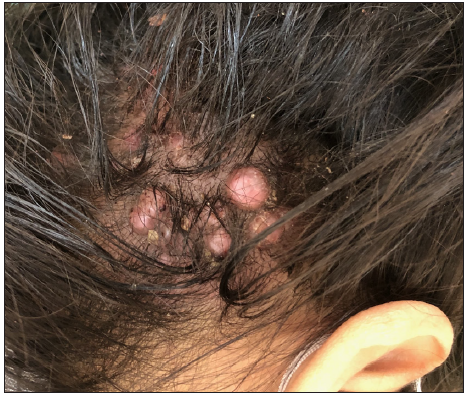
Export to PPT
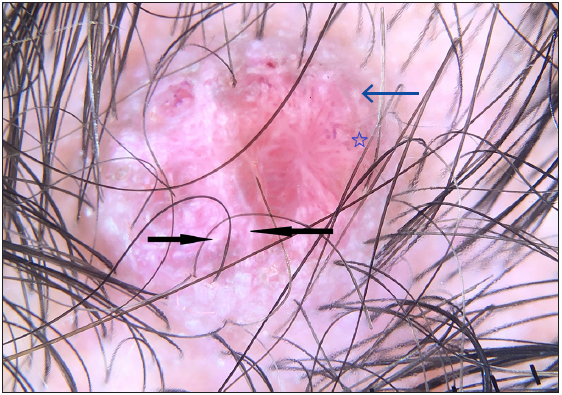
Export to PPT
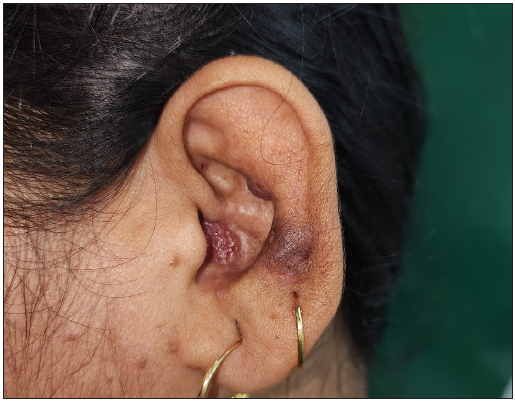
Export to PPT

Export to PPT
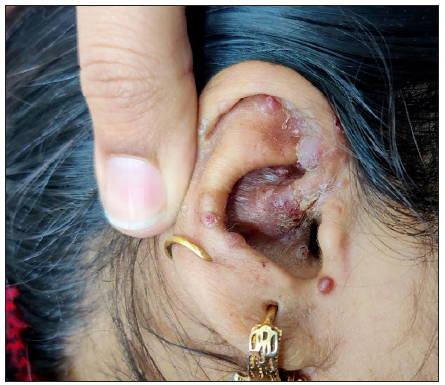
Export to PPT
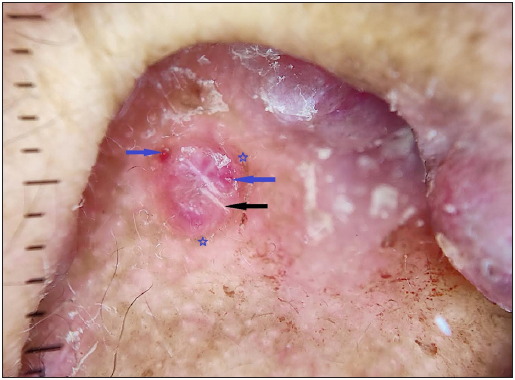
Export to PPT

Export to PPT
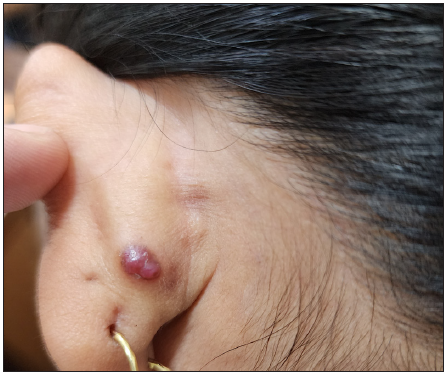
Export to PPT
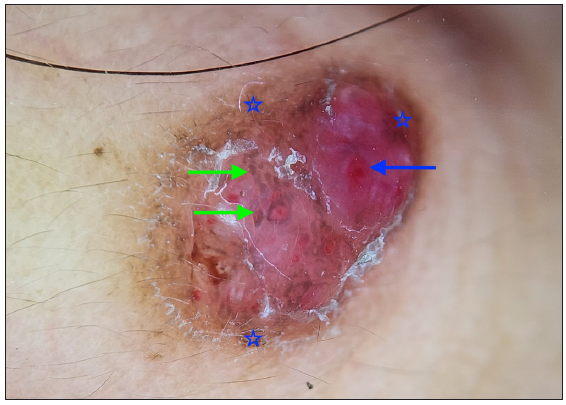
Export to PPT
Literature on dermoscopy of ALHE is limited to a handful of reports [Tables 2 and 3]. Of a total of 9 cases of dermoscopy of ALHE described hitherto in the literature, only one was in skin of colour. Previous reports have reported red-to-reddish purple lacunae, polymorphic vessels, and white structures over a red-to-pink background in dermoscopy of ALHE.4–7 The findings in the present study align with those described earlier. However, we found polarisation-specific white areas and pigmentation structures to be prominent features, apart from vessels and red lacunae. On dermoscopic-histological correlation, the presence of vessels, clods (red-purple lacunes), and pink background could represent a combination of underlying vascular proliferation with plump endothelial cells, intraluminal erythrocytes and haemorrhage, whereas polarisation-specific white structures might be due to underlying stromal fibrosis and alteration in collagen orientation secondary to vascular proliferation. The pigmentation structures in brown structureless zones/dots/lines, peripheral rim of hyperpigmentation, and pigment network could be due to pigmented skin phototype (IV-V). The presence of peripheral rim of hyperpigmentation, also seen in dermatofibroma, has been linked to trauma as an underlying etiological factor.2 However, no such history was elicited in our patients. We compared the dermoscopic findings between early and late lesions, which revealed more clods, red or purple and erosions in the former. In contrast, late lesions had brown structures (structureless zones, lines), pigment networks, white lines and white dots more frequently. This corroborates with the histological spectrum of ALHE, which varies according to the stage of the lesion, with vascular components more prominent in early lesions and later lesions showing inflammation around mature smaller endothelial cells and stromal fibrosis.
Table 2: Summary of reported cases of ALHE in the literature
Author (Year of publication) Number of cases Age (years)/sex, skin type Location of the lesions Clinical history/morphology History of trauma/associationsDermoscopic setting
(polarisation or not/magnification)
Rodriguez Lomba,
et al.5 2016
245,
Male,
NS
17, female
The inner aspect of the left thigh
Front of neck
Asymptomatic pink-coloured nodule
Asymptomatic, multiple nodules
NS
NS
polarised/NS
polarised/NS
Santosa C, et al.7 2019 155, male,
NS
Nose Solitary, 0.5 cm nodule with a solitary ulcer. History of bleeding. NS NS/NS Baştuğ NB, et al.2 2019 240, female, NS
60, female, NS
Frontotemporal area
Periauricular region
Pink-to-red grouped nodules, rim of brown dots, history of bleeding present
There are few pinkish nodules and a history of bleeding after trauma
NS Non-polarised/NS Zhang LW, et al.6 2019 1 24, male, NS Scalp Multiple, asymptomatic, dome-shaped papules NS NS/NS Kalantri M, et al.1 2020 1 25, female, NS Scalp Multiple, asymptomatic erythematous to skin coloured, discrete and grouped, dome-shaped papules and nodules Pregnancy Polarised/x200 Akay BN, et al.4 2021 246, female, NS
35, male, NS
Right posterior auricular area
Left preauricular area
Asymptomatic multinodular reddish lesion
Pruritic, multiple, pink-coloured papules
NS NS/NSTable 3: Summary of reported dermoscopic findings
Study Dermoscopic findings (prevalence in percentage) Corresponding terminology based on the International Dermoscopy Society consensus paperRodriguez-Lomba,
et al.5 2016
Polymorphic vascular pattern (100%) (dotted, corkscrew, linear irregular vessels)
Background-Diffuse pale-reddish (50%), light-pink background (50%)
Polymorphous vessels- Dotted, helical, serpentine
Structureless zone- red, pink
Santosa C, et al.7 2019Keratin mass (100%)
Pink background (100%)
Ulcer on the centre (100%)
Polymorphic vessels (Dotted, globular, linear irregular) (100%)
White structureless zone, lines, globules
Structureless zone-pink
Ulceration
Polymorphous vessels- dotted, serpentine
Baştuğ NB, et al.2 2019Irregular brown linear structures (50%)
Red background (50%)
Rim of brown dots (100%)
Reddish-purple lacunes 50%)
Irregular vascular structures (50%)
Occasional white structureless areas (50%)
Peripheral white haloes around brown dots (50%)
Zhang LW, et al.6 2019 Kalantri M, et al.1 2020White, shiny, irregular areas
White shiny streaks
Vessels-dots, globules, linear, linear irregular, reticular
Background-pink white, yellow-orange
Yellow-orange crust
White structureless zone
White lines
Polymorphous vessels-dotted, linear, serpentine branched
Structureless zone- any colour (pink, yellow-orange)
NA
Akay BN, et al.4 2021Red clods (100%)
Vessels- dotted vessels (50%), serpentine looped (50%)
Subtle white lines (100%)
Structureless area- pink (50%), pink brown (50%)
Clods
Vessels- dotted, serpentine, looped
White lines
Structureless zone- any colour (pink, pink, brown)
ALHE can act as a diagnostic challenge with a long list of differentials, including pyogenic granuloma, dermatofibroma, pseudolymphoma and Kaposi sarcoma, to name a few [Figures 3a–f]. The presence of a combination of the polymorphic vessels, white and brown structures, clods (red-purple lacunes) with pink structureless zones and erosions could be helpful dermoscopic clues in the diagnosis of ALHE when faced with red-to-pink papulonodules, although more studies with a higher number of patients are needed to affirm findings of the present study.
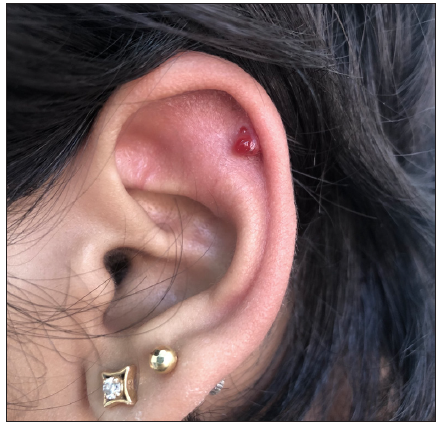
Export to PPT
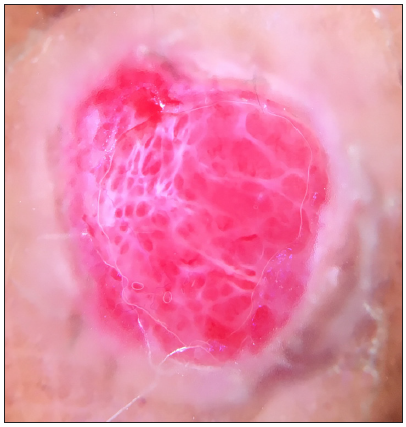
Export to PPT
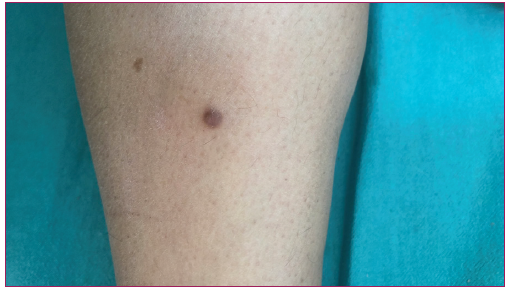
Export to PPT

Export to PPT

Export to PPT
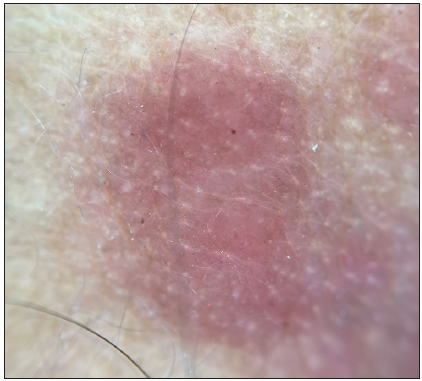
Export to PPT
留言 (0)